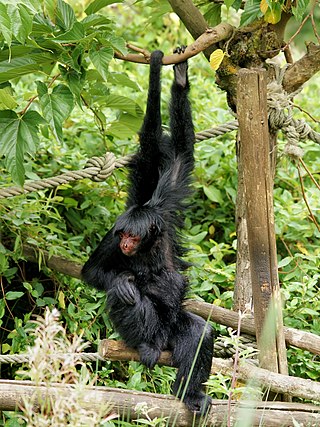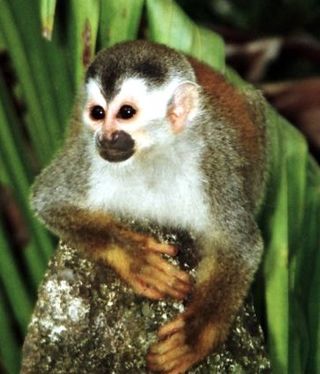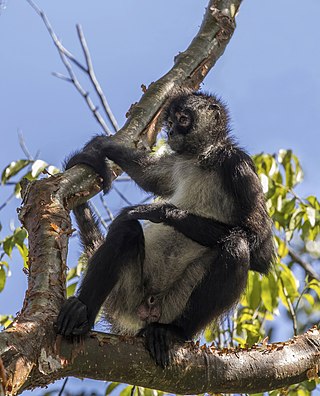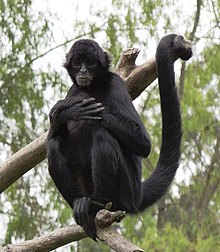
The woolly monkeys are the genus Lagothrix of New World monkeys, usually placed in the family Atelidae.

The Atelidae are one of the five families of New World monkeys now recognised. It was formerly included in the family Cebidae. Atelids are generally larger monkeys; the family includes the howler, spider, woolly, and woolly spider monkeys. They are found throughout the forested regions of Central and South America, from Mexico to northern Argentina.

The gray-bellied night monkey, also called the grey-legged douroucouli or lemurine owl monkey, is a small New World monkey of the family Aotidae. Native to tropical and subtropical forests of South America, the gray-bellied night monkey faces a significant threat from hunting, harvesting for use in pharmaceutical research and habitat destruction.

Spider monkeys are New World monkeys belonging to the genus Ateles, part of the subfamily Atelinae, family Atelidae. Like other atelines, they are found in tropical forests of Central and South America, from southern Mexico to Brazil. The genus consists of seven species, all of which are under threat; the brown spider monkey is critically endangered. They are also notable for their ability to be easily bred in captivity.

The mantled guereza, also known simply as the guereza, the eastern black-and-white colobus, or the Abyssinian black-and-white colobus, is a black-and-white colobus, a type of Old World monkey. It is native to much of west central and east Africa, including Cameroon, Equatorial Guinea, Nigeria, Ethiopia, Kenya, Tanzania, Uganda and Chad. The species consists of several subspecies that differ in appearance. It has a distinctive appearance, which is alluded to in its name; the long white fringes of hair that run along each side of its black trunk are known as a mantle. Its face is framed with white hair and it has a large white tail tuft.

The red-faced spider monkey, also known as the Guiana spider monkey or red-faced black spider monkey, is a species of spider monkey found in the rain forests in northern South America.

The Central American squirrel monkey, also known as the red-backed squirrel monkey, is a squirrel monkey species from the Pacific coast of Costa Rica and Panama. It is restricted to the northwestern tip of Panama near the border with Costa Rica, and the central and southern Pacific coast of Costa Rica, primarily in Manuel Antonio and Corcovado National Parks.

Geoffroy's spider monkey, also known as the black-handed spider monkey or the Central American spider monkey, is a species of spider monkey, a type of New World monkey, from Central America, parts of Mexico and possibly a small portion of Colombia. There are at least five subspecies. Some primatologists classify the black-headed spider monkey (A. fusciceps), found in Panama, Colombia, and Ecuador as the same species as Geoffroy's spider monkey.

The white-cheeked spider monkey is a species of spider monkey, a type of New World monkey, endemic to Brazil. It moves around the forest canopy in small family groups of two to four, part of larger groups of a few dozen animals. This monkey feeds on leaves, flowers, fruits, bark, honey and small insects, and it is an important means of seed dispersal for forest trees. Females give birth after a 230-day gestation period. The population of this monkey is decreasing as its forest habitat is lost to soybean production, deforestation and road construction. It is also regarded as a delicacy and hunted for food. For these reasons, the International Union for Conservation of Nature has assessed the animal's conservation status as being "endangered".

The Peruvian spider monkey, also known as the black-faced black spider monkey, is a species of spider monkey that lives in Peru, as well as in Brazil and in Bolivia. At 60 centimetres long, they are relatively large among species of monkey, and their strong, prehensile tails can be up to 1 m (3 ft) long. Unlike many species of monkey, they have only a vestigial thumb, an adaptation which enables them to travel using brachiation. Peruvian spider monkeys live in groups of 20–30 individuals, but these groups are rarely all together simultaneously. The size and dynamics of the resulting subgroups vary with food availability and sociobehavioral activity. They prefer to eat fleshy fruit, but will change their diet in response to scarcity of ripe fruit. Individuals of this species also eat small animals, insects and leaves based on availability. Females separate from the band to give birth, typically in the fall. These females inhabit a group of core areas where resources are abundant in certain seasons. Typically, males exhibit ranging over longer distances than females, with movement of individuals enhancing the fluidity of subgroup size. Peruvian spider monkey are independent at about 10 months, with a lifespan of about 20 years.

The brown spider monkey or variegated spider monkey is a critically endangered species of spider monkey, a type of New World monkey, from forests in northern Colombia and northwestern Venezuela.

The red-headed barbet is a species of bird in the family Capitonidae, the New World barbets. It is found in Costa Rica, Guyana, Panama, Venezuela, Colombia, Ecuador and Peru.

The brown-headed spider monkey is a critically endangered subspecies of the black-headed spider monkey, a type of New World monkey, found in northwestern Ecuador.
The hooded spider monkey is a subspecies of Geoffroy's spider monkey, a type of New World monkey, from Central America, native to Panama. It also might be found in a small portion of Colombia adjacent to Panama. In western Colombia and northeast Panama it is replaced by the Black-headed spider monkey, A. fusciceps. In western Panama, it is replaced by another subspecies of Geoffroy's Spider Monkey, the Ornate spider monkey, A. g. ornatus. The Hooded spider monkey has long, tawny fur.

The Mexican spider monkey, also known by its mayan name "Ma'ax", is a subspecies of Geoffroy's spider monkey, and is one of the largest types of New World monkey. It inhabits forests of Mexico, Guatemala, Belize, El Salvador and Honduras. It is a social animal, living in groups of 20–42 members. The subspecies is considered to be an endangered according to the IUCN Red List since 2020, mostly due to human threats.

The Colombian spider monkey is a subspecies of the Black-headed spider monkey, a type of New World monkey, found in Colombia and Panama. Some authorities, such as Froelich (1991), Collins and Dubach (2001) and Nieves (2005), do not recognize the Black-headed spider monkey as a distinct species and so treat the Colombian spider monkey as a subspecies of Geoffroy's spider monkey.

The Azuero spider monkey is a possible subspecies of spider monkey that is in critical danger of extinction according to the IUCN Red List of Threatened Species. Common names of this subspecies include mono charro, mono charao and mono araña. The Azuero subspecies is one of three types of spider monkeys in Panama; Ateles geoffroyi panamensis with a range spanning from Costa Rica to Darién excluding the Azuero, Ateles geoffroyi fusciceps, with a range spanning Panamá and Colón provinces, and Ateles geoffroyi azuerensis, the Azuero spider monkey, whose range encompasses only the Azuero Peninsula.

The Eastern Panamanian montane forests (NT0122) is an ecoregion in the east of Panama and the extreme northwest of Colombia. It contains diverse flora and fauna, with considerable endemism. The ecoregion is largely intact due to its inaccessibility, although the opening of an extension of the Pan-American Highway has introduced threats from human activity.





















